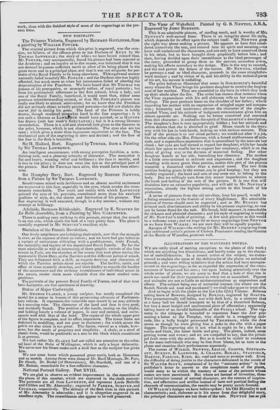Adelaide, Baroness Ribblesdale. Engraved by E. SCRIVEN for La Belle
Assenzblee, from a Painting by Mrs. CARPENTER.
There is nothing very striking in this portrait, except that the mouth is on one side, which spoils the look of a very pretty face. The plate is carefully engraved in Mr. SCRIVEN'S excellent style.
Sketches of the French Revolution.
Our lively neighbours are indulging their mirth, now that the struggle is over, at the expense of their ex-rulers ; and we have had put before us
a variety of caricatures ridiculing with a good-humour, truly French, the imbecility and bigotry of the expatriated Royal Family. By far the most admirable as well as interesting of these graphic records of the late events in Paris, are the sketches of the scenes that took place during the memorable Three Days, at the Barriers and the different points of attack. They are delineated with a skill, as regards drawing and character, of which the Parisian artists alone are capable. The facility, spirit, and effect of these masterly sketches, and their fidelity as regards the locality of the occurrences and the striking resemblances of individual actors in the scenes, render them more valuable than the most studied com- positions.
The portraits of the present Royal Family of France, and of that true hero Lafayette, are fine specimens of drawing.
Statue of Major Cartwright.
Mr. GEORGE CLARKE, a young sculptor, has nearly completed the model for a statue in bronze of this persevering advocate of Parliamen-
tary reform. It represents the venerable man seated in an easy attitude in a morning robe. The character of the head and face is very good, and decidedly Scotch. The position of the hands, resting on the thighs, and holding, loosely a volume of papers, is easy and natural,. and corre- sponds well with that of the head. The repose of the whole upper part of the figure is complete, and its effect impressive. The lower limbs are deficient in modelling, and are poor in character; the width across the pelvis we also think is too great. The figure, viewed as a whole, how- ever, has the merit of propriety and simplicity. A chair, or a stool of classic form, would be preferable as a seat to the block which constitutes it at present.
We had rather Mr. Cr. KE had not called our attention to the colos- sal head of the Duke of Wellington, which is only a }nose deformity. We never saw his Grace make such a droll face as the sculptor has given him.
We saw some busts which possessed great merit, both as likenesses and as models. Among them were those of Mr. Basil Montagu, Dr. Parr, Dr. Sleath, Dr. Butler (of Shrewsbury), Mr. Stanfield, and one of a Mr. Badam, remarkable for a fine reflective character.


























 Previous page
Previous page